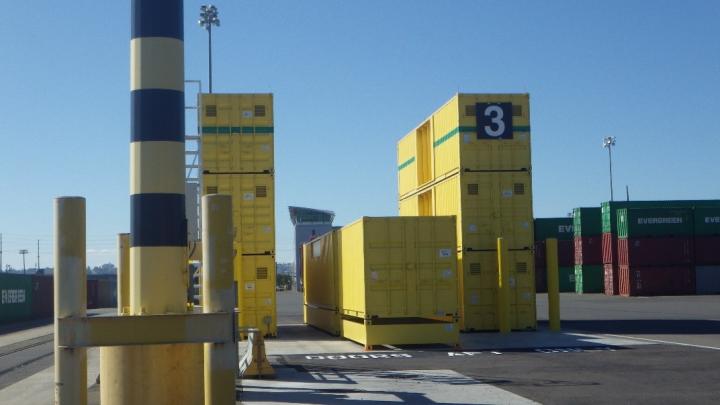
Credit: Dept. of Homeland Security
AIKEN, S.C. (Nov. 1, 2019) – After years of development and testing, a radiation detection system developed by the Department of Energy’s Savannah River National Laboratory is now in full-scale operation at major United States shipping ports.
In 2018, the SRNL-designed and tested On-Dock Rail Straddle Carrier Portal Monitoring System was commissioned and put into operation at the Port of Tacoma, Washington. In 2019, the system was duplicated, commissioned and put into service at Maher Terminal, Port of New York/New Jersey. The systems were developed with funding from the Department of Homeland Security and will be operated by that agency’s U.S. Customs and Border Protection organization. Pacific Northwest National Laboratory will assist in both locations with ongoing operational support.
The system is designed to detect illicit radioactive material in intermodal cargo containers. It is built to provide an efficient way to monitor cargo as it is transferred from ship to rail for ground transport.
The SRNL design uses multiple radiation monitoring panels mounted into the sides of inter-modal cargo containers, more commonly known as shipping containers. Shipping containers are used to move a large percentage of the goods that are exchanged in international trade. As large straddle carriers unload multiple stacks of containers, they can be transported and scanned through the monitoring panels of the Straddle Carrier Portal system prior to loading on rail cars.
The system is expected to save significant time and space requirements for scanning these containers.
“This is the result of the application of a range of competencies and the creativity of a number of people at the National Lab and the Savannah River Site,” said David Wilson, Associate Laboratory Director for National Security for Savannah River National Laboratory. “We have not only enhanced our national security, but we’ve delivered on a system that can do so while increasing the efficiency of operations at these ports. This is the kind of practical application of science that this Lab does best.”
The Straddle Carrier Portal has been in development and testing at SRNL since 2011. SRNL personnel completed data collection testing that year using a straddle carrier deployed at SRS to transport a wide range of test containers holding varieties of radioactive sources packaged in different shielded configu- rations. A prototype was installed in fall 2011 at the Port of Virginia, and the system was refined and upgraded in subsequent years in anticipation of permanent installation and operation at a sea ports, like the Ports of Tacoma and New York/New Jersey.
###
The United Stated Department of Energy (DOE) Savannah River National Laboratory (SRNL) is a multi-program research and development center that puts science to work to protect the nation by providing practical, cost-effective solutions to the nation’s environmental, nuclear security, nuclear materials management, and energy manufacturing challenges. SRNL is managed for DOE by Savannah River Nuclear Solutions, a Fluor-led company whose members are Fluor Federal Services, Newport News Nuclear and Honeywell.
Visit us on the web at http://srnl.
Media Contact
Christian Harris
[email protected]
803-725-5819
Original Source
https:/




